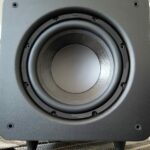Do Acoustic Panels Work Both Ways? (Explained)
Do Acoustic Panels Work Both Ways? (Explained)

Do acoustic panels work both ways?
It’s a good question and one I’ve actually been asked a few times.
Now if you remember, we previously went over how placing an acoustic panel behind your speakers is definitely a great idea since it basically helps improve the sound you experience in that room.
But here’s an interesting thought, is the quality of your soundproofing affected by how you actually place the panel itself?
The answer to that is actually pretty interesting, so let’s just get right to it.
Do Acoustic Panels Work Both Ways? A Quick Summary
Yes acoustic panels work both ways, but they work best when placed with the textured side showing. This is because the uneven and angled texture helps to better trap sound waves, preventing them from being reflected. When placed with the flat side showing, sound waves might reflect more due to the uniformity of that panel’s surface creating less friction.
What Are Acoustic Panels?
Now just for a quick recap, acoustic panels are light weight panels that come in varying sizes & materials, and are basically used to help get rid of extra sound reflections that might occur in a room.
By implementing sound panels, you can minimize this issue while actually improving your current sound (plus they make a great gift idea)
Contrary to popular belief, sound panels aren’t used to actually soundproof a room since soundproofing involves separating the sound in a specific room from another area that you’d want to prevent that sound from leaking into (acoustic tiles are typically better in that regard).
This means it would likely take various methods to properly achieve this (such as decoupling, bass traps, diffusers, filling the walls with dense fibrous material for sound absorption, incorporating mass into the room itself, etc)
Rather, the primary job of a sound panel and what they do focus on is reducing reflected sound waves within a room so that those same waves don’t reflect and collide into each other (since that can impact your sound)
I guess I’ll caveat that by saying that they technically can be used for soundproofing if they’re used in conjunction with those other methods (if we’re being technical lol) but used alone that’s not really their focus.
Funnily enough, I personally use sound panels in my own home theater and it surprisingly makes a bigger difference than you’d initially think.
It’s an easy way to improve your sound quality even before even calibrating your speakers or anything (provided you install them correctly of course)
.
Check Availability TroyStudio Acoustic Studio Absorption Foam Panel
That being said, there’s actually a bunch of different types which may suit different rooms & styles so I’ll quickly go over those since it’ll add a little more context to our original question.
The Different Types Of Acoustic Panels
Convoluted Foam/ Egg Crate Foam Panels
The first type of acoustic panels are what are known as convoluted foam panels or similarly, egg crate foam panels due to the fact that well….they look similar to an egg crate.
Because they do a great job with helping with reflected sound in a room, they can sometimes be a decent amount thicker and can even be cut smaller which is helpful.
I’ve had these kind of panels before and noticed that they tend to come shrink wrapped beforehand so it’s likely that you’ll need to wait a little bit for them to expand to their full size — though they definitely do a good job in my opinion.
Check Availability Of Convoluted Egg Crate Foam Panels
Acoustic Fiberglass Panels
Acoustic fiberglass panels, like egg crate foam panels, are also pretty large at around 2 feet to even 4 feet; however they’re less thick at around 3/4 of an inch to 2 inches and typically can’t be cut since they often come in set sizes (unless you create custom ones)
Due to the coarser material it often does a better job with actually reducing unwanted sound waves.
In fact, I feel like these tend to do the best job when it comes to that, and are better suited in larger more symmetrical rooms from what I’ve noticed.
A little tip you might also find useful is leaving anywhere from about a half inch to an inch of space between the wall and the panel.
What this does is it gives more room for the soundwave to pass through easier so that it can quickly reduce that reflection.
But what’s really cool is that from there, that same sound wave is then reflected off the wall and back through the panel again a second time; essentially giving you double the efficacy in reducing any reflections present.
Check Availability Of Fiberglass Acoustic Panels
Ridge/Wedge Foam Panel
Probably one of the most common designs and likely one you may have seen at some point, the ridge/wedge is often a favorite used by many.
From famous musicians to streamers, ridge panels are used due to their sheer versatility.
Since they’re symmetrical, they can be placed horizontally or vertically, and often come in lots of different colors — meaning they can easily be integrated with the theme of the room.
I find that these help with acoustic treatment too when placed correctly in a room.
Check Availability Of Wedge Acoustic Panels
Periodic Groove Structure Panels
These panels are uneven in structure based on the idea that when a sound wave hits it, the uneven nature does a better job at breaking up the cohesiveness of that actual sound wave when it travels around.
This in turn, could help in reducing the amount of peaks and nulls in a room, giving you a much more fulfilling and satisfying listening experience.
To put it simply, while these panels might look more uneven than the other types, it’s actually because of that, in my opinion, that they benefit from this and help with audio performance in a room.
Check Availability Of Periodic Groove Structure Panels
Do Acoustic Panels Work Both Ways
So the original question, do acoustic panels work both ways?
Well yes, to an extent.
Acoustic panels are designed to be placed on the wall flat side down, with the textured side that’s visible being responsible for disrupting the sound wave that’s reflected.
It’s the texture on the front of the acoustic panel that helps break up the sound wave since it can’t reflect off the surface as easily due to the the various angles and grooves that helps absorb these vibrations.
When you flip the panel, and place it flat side up, sound waves might potentially have an easier time reflecting off it which could unfortunately affect the sound quality in the room.
While it’d still technically work, since some of the sound would still pass through the material, it wouldn’t be nearly as performant in my opinion since there wouldn’t be the same amount of friction (though even that depends since every room is different)
Long story short, I would recommend using it flat side down as that’s the intended usage and what works best.
How Far Apart Should Acoustic Panels Be Placed?
As far as actually placing the acoustic panels is concerned, they should be placed anywhere where the sound waves are reflected which can be different for each room.
In professional studio settings or even dedicated theater rooms, you ideally want to cover anywhere from 60 to even 70 percent of the room for the better audio performance.
This tends to offer the best balance between minimizing echoes while maintaining the overall characteristics of the room since too much can make the room feel flat with dynamism of the audio.
Keep in mind you likely want to still keep some reflective materials and not cover everything since that can deaden the room by negatively impacting the spaciousness and imaging of your speakers.
By keeping some reflective materials, it allows the room to still maintain some semblance of liveliness so that it isn’t overbearing — while still providing a proper surround sound experience.
Final Thoughts
Hopefully this helped clear up whether using the other side of an acoustic panel is a good idea, and you’re aware of the various types that actually exist.
Acoustic treatment is often overlooked when it comes to the average home theater, but it’s one of those things that offers immediate improvements to sound when done properly.
That’s all I have for now. Until next time.
Make it easy, keep it simple! ?
About Me

Jay
Hey everyone it’s nice to meet you. I'm Jay, writer & founder of the site Easy Home Theater. I've been with this hobby of home entertainment for many years now. I decided to create this site to be a helpful resource, and share everything that I've learned from personal experience with you. I also happen to be a huge gamer, lover of all things tech related, and a major fitness buff (love weightlifting)
Contact: Contact Jay
Facebook: https://www.facebook.com/Easyhometheater/
X: https://x.com/easyhometheater
Pinterest: https://www.pinterest.com/easyhometheater/pins/
Instagram: https://www.instagram.com/easyhometheater/
Followit: https://follow.it/easy-home-theater
Bluesky: https://bsky.app/profile/easyhometheater.bsky.social







Leave a Reply